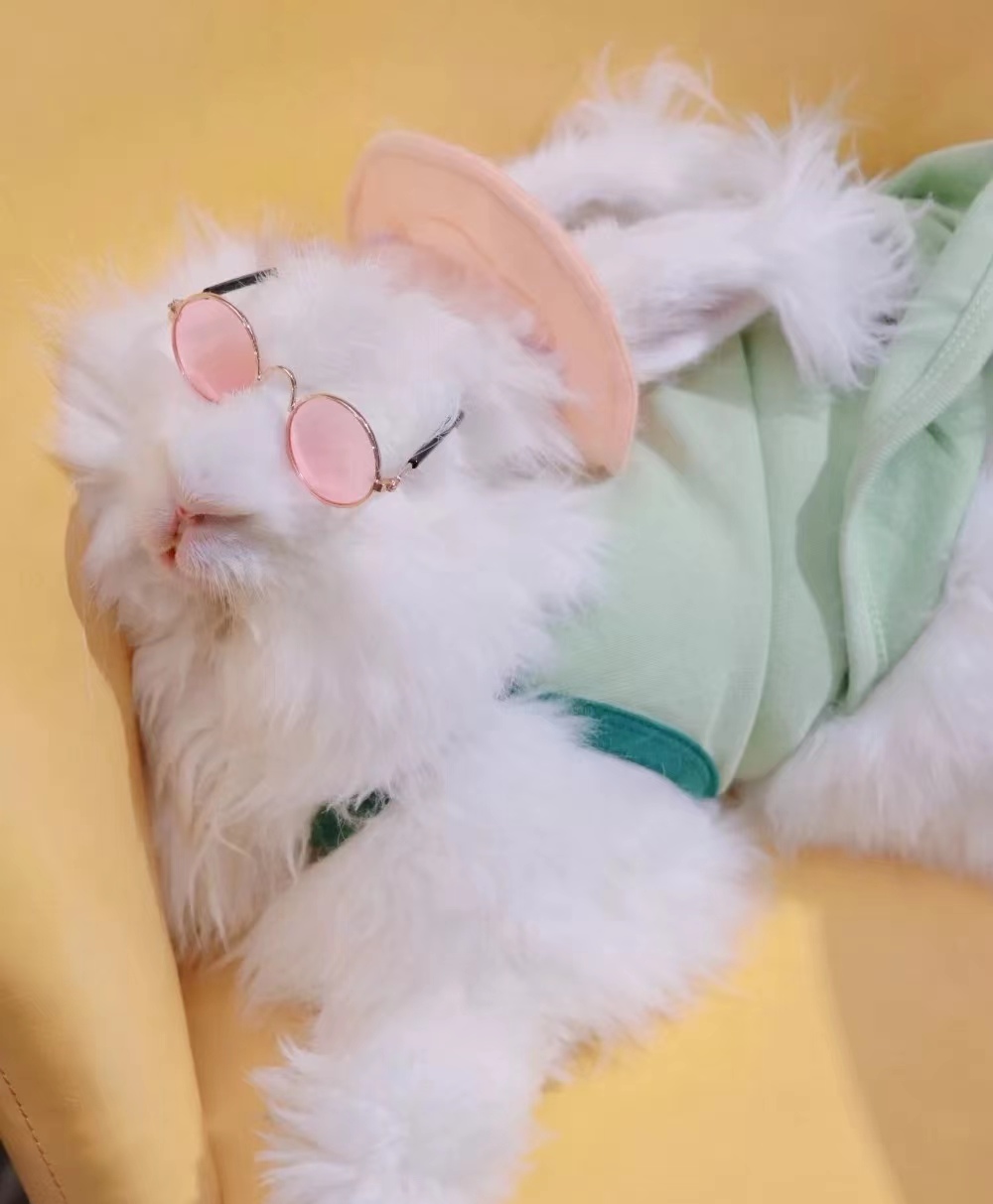


長毛兔養(yǎng)殖中的感染防護(hù)措施解析
 發(fā)布日期:2025-07-09
來源:http://www.lyhggs.com 發(fā)布人:創(chuàng)始人
發(fā)布日期:2025-07-09
來源:http://www.lyhggs.com 發(fā)布人:創(chuàng)始人
長毛兔養(yǎng)殖過程中,做好感染防護(hù)是保障其健康生長的關(guān)鍵,需從環(huán)境、飼養(yǎng)、護(hù)理等多方面綜合施策。
During the breeding process of long haired rabbits, effective infection prevention is the key to ensuring their healthy growth, and comprehensive measures need to be taken from multiple aspects such as environment, feeding, and care.
養(yǎng)殖環(huán)境的清潔與是基礎(chǔ)防護(hù)環(huán)節(jié)。兔舍應(yīng)保持干燥、通風(fēng),避免潮濕陰暗,因?yàn)槌睗癍h(huán)境易滋生細(xì)菌和寄生蟲。每天需及時(shí)清理兔舍內(nèi)的糞便、剩余飼料等污物,定期對(duì)兔舍地面、墻壁、食槽、飲水器等進(jìn)行徹底。可選用的藥劑,按照合適比例稀釋后噴灑或擦拭,頻率根據(jù)養(yǎng)殖密度和季節(jié)調(diào)整,高溫高濕季節(jié)可適當(dāng)增加次數(shù),以減少病原體滋生。同時(shí),要合理控制養(yǎng)殖密度,避免兔群過度擁擠,保證每只長毛兔有足夠的活動(dòng)空間,降低相互接觸感染的風(fēng)險(xiǎn)。
The cleaning and disinfection of the breeding environment are fundamental protective measures. The rabbit house should be kept dry and ventilated, avoiding dampness and darkness, as damp environments can easily breed bacteria and parasites. Every day, it is necessary to promptly clean up the feces, remaining feed, and other dirt in the rabbit house, and regularly disinfect the floor, walls, food troughs, water dispensers, etc. of the rabbit house thoroughly. Safe disinfectants can be selected, diluted in appropriate proportions and sprayed or wiped. The disinfection frequency can be adjusted according to the breeding density and season, and the frequency can be increased appropriately during high temperature and high humidity seasons to reduce the growth of pathogens. At the same time, it is necessary to reasonably control the breeding density, avoid overcrowding of rabbit herds, ensure that each long haired rabbit has sufficient activity space, and reduce the risk of mutual contact and infection.

飼料與飲水的管理也不容忽視。飼料需保證新鮮、無霉變,霉變飼料中含有的有害物質(zhì)可能導(dǎo)致長毛兔消化系統(tǒng)受損,降低免疫力,增加感染幾率。飼喂時(shí)應(yīng)定時(shí)定量,避免飼料堆積變質(zhì)。飲水要清潔衛(wèi)生,使用自動(dòng)飲水器,防止水源被糞便、污物污染,定期清洗飲水設(shè)備,確保長毛兔隨時(shí)能喝到干凈的水。此外,可在飼料中適當(dāng)添加維生素、礦物質(zhì)等營養(yǎng)物質(zhì),增強(qiáng)長毛兔的機(jī)體抵抗力,提高其對(duì)病原體的抵御能力。
The safety management of feed and drinking water cannot be ignored. Feed should be kept fresh and free from mold. Harmful substances contained in moldy feed may damage the digestive system of long haired rabbits, reduce immunity, and increase the risk of infection. Feeding should be timed and quantified to avoid the accumulation and deterioration of feed. Drinking water should be clean and hygienic, preferably using an automatic water dispenser to prevent contamination of the water source by feces and dirt. Regularly clean the drinking water equipment to ensure that the long haired rabbit can drink clean water at any time. In addition, vitamins, minerals and other nutrients can be appropriately added to the feed to enhance the body's resistance of long haired rabbits and improve their ability to resist pathogens.
日常護(hù)理中的細(xì)節(jié)防護(hù)同樣重要。長毛兔的毛發(fā)較長,容易沾染污物和寄生蟲,需定期梳理毛發(fā),及時(shí)毛發(fā)中的雜質(zhì)和脫落的絨毛,保持毛發(fā)清潔干燥。梳理過程中還能觀察皮膚是否有紅腫、破損、結(jié)痂等異常情況,一旦發(fā)現(xiàn)及時(shí)處理。在抓握長毛兔時(shí),動(dòng)作要輕柔,避免因粗暴操作導(dǎo)致其皮膚受傷,皮膚破損后易受到病原體侵襲引發(fā)感染。同時(shí),要避免不同來源的長毛兔混養(yǎng),新引入的長毛兔需隔離觀察一段時(shí)間,確認(rèn)健康后方可放入養(yǎng)殖群,防止外來病原體傳入。
Detail protection is equally important in daily care. Long haired rabbits have long hair and are prone to contamination by dirt and parasites. It is necessary to regularly comb their hair, remove impurities and shed fur in a timely manner, and keep the hair clean and dry. During the combing process, it is also possible to observe whether there are any abnormal conditions such as redness, swelling, damage, scabbing, etc. on the skin, and promptly deal with them once discovered. When grasping a long haired rabbit, the movements should be gentle to avoid skin injuries caused by rough handling, which can easily lead to pathogen invasion and infection. At the same time, it is necessary to avoid mixing long haired rabbits from different sources. Newly introduced long haired rabbits need to be isolated and observed for a period of time to confirm their health before being placed in the breeding group to prevent the introduction of foreign pathogens.
疾病監(jiān)測與早期干預(yù)是預(yù)防感染擴(kuò)散的關(guān)鍵。養(yǎng)殖人員應(yīng)每天觀察長毛兔的精神狀態(tài)、食欲、糞便等情況,若發(fā)現(xiàn)長毛兔出現(xiàn)精神萎靡、食欲減退、腹瀉、呼吸困難等異常癥狀,需及時(shí)將其隔離,防止與其他健康兔接觸。對(duì)隔離的病兔,要仔細(xì)觀察癥狀,判斷可能的感染類型,輕度癥狀可嘗試采取相應(yīng)的護(hù)理措施,若癥狀無改善或加重,應(yīng)及時(shí)尋求人員的幫助,采取合理的方案,避免病情蔓延。此外,定期對(duì)長毛兔進(jìn)行健康檢查,了解其健康狀況,為防護(hù)措施的調(diào)整提供依據(jù)。
Disease monitoring and early intervention are key to preventing the spread of infection. Breeding personnel should observe the mental state, appetite, feces, and other conditions of long haired rabbits every day. If abnormal symptoms such as mental fatigue, decreased appetite, diarrhea, and difficulty breathing are found in long haired rabbits, they should be isolated in a timely manner to prevent contact with other healthy rabbits. For isolated sick rabbits, the symptoms should be carefully observed to determine the possible type of infection. For mild symptoms, corresponding nursing measures can be attempted. If the symptoms do not improve or worsen, professional help should be sought in a timely manner, and a reasonable treatment plan should be adopted to avoid the spread of the disease. In addition, regular health checks should be conducted on long haired rabbits to understand their health status and provide a basis for adjusting protective measures.
本文由長毛兔友情奉獻(xiàn).更多有關(guān)的知識(shí)請(qǐng)點(diǎn)擊:http://www.lyhggs.com我們將會(huì)對(duì)您提出的疑問進(jìn)行詳細(xì)的解答,歡迎您登錄網(wǎng)站留言.
This article is a friendly contribution from Long haired Rabbit For more information, please click: http://www.lyhggs.com We will provide detailed answers to your questions. You are welcome to log in to our website and leave a message